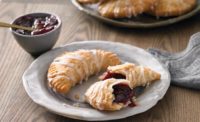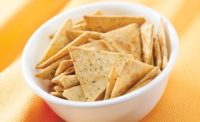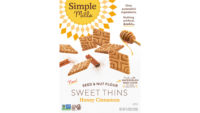Batters and Coatings Combine Functionality and Flavor with Texture Appeal and Visual Enticement
Coatings provide a variety of new flavors, texture, appearance, and mouthfeel

PHOTO COURTESY OF: Mauna Loa Macadamia Nut Corp. (www.maunaloa.com)

Multiple coatings, combining different textures and flavors, are trending such as with a battered and deep-fried grilled cheese sandwich.
PHOTO COURTESY OF: Rich Products Corp. (www.farmrich.com)

Fried chicken — whether Southern US style or in its myriad global variations — is the pinnacle of battered and coated foods, evoking powerful emotions for millions of consumers.
PHOTO COURTESY OF: getty images

As important as is the coating in a fried product, so too is the oil it’s fried in to ensure proper texture, color, and flavor.
PHOTO COURTESY OF: Manitoba Canola Growers Assn. (www.canolagrowers.com)

Nuts bring texture, flavor, and extra nutrition such as protein and minerals to a gluten-free coating equally suitable for sweet or savory formulations.
PHOTO COURTESY OF: getty images (www.gettyimages.com)





The addition of coatings to foods is more than structural. Batters and breadings are used to enhance the whole eating experience, and perhaps even add some unexpected twist. Whether a fluffy beer batter on a piece of fried fish, a crunchy cornflake coating on an oven-fried chicken drumstick, or even a thin salt-and-spice crust on a steak, the outside is the first line of attraction for any food.
Coatings provide a variety of new flavors, texture, appearance, and mouthfeel to foods that might be good on their own, but with the addition of a little something extra, become great. A well-chosen breading, batter, or coating can add just the right touch to make a food novel, memorable, and enticing enough to become a favorite “turn to” for consumers.
While restaurant chefs can manipulate the recipe, cooking conditions, and equipment on the fly, it’s a different story when translating such innovations to mass production for commercial sale. The product must appeal to thousands of consumers and conform to a variety of cooking skills and equipment. However, imparting these unique twists on flavor, appearance, and texture can be relatively easy to accomplish.
Comfort Classic
Fried chicken could easily be declared the pinnacle of battered and coated foods. It’s unpretentious, versatile, delicious, and ubiquitous. And in recent years, it has expressed its global nature, with items such as Thai- and Korean-style fried chicken enjoying popularity. Fried chicken simply evokes powerful emotions for millions of consumers.
Aside from the specific spice combinations used, fried chicken is typically comprised of a simple formula: chicken, seasoning, flour, batter (milk and egg), more flour, and then into the fryer. Straightforward and delicious. However, its main downfall in batch production is that all that deliciousness—the flavor, the texture—doesn’t keep.
In a Glaze
A glaze can add a real flavor “zing” to a coating. Trending flavor profiles char siu (Cantonese barbecue) and pinoy (Filipino barbecue) rely on glazes for their signature profiles. A classic char siu glaze is composed of honey, Chinese five spice, miso paste, hoisin sauce, and soy sauce. It typically is used to glaze pork. Pinoy is built on a base of banana ketchup, a highly popular condiment in the Philippines.
It includes pepper, brown sugar, salt, and garlic. Most glazes have high brix, as they contain a comparatively large amount of sugar. Many commercial glazes also use maltodextrin to promote clinginess in the glaze. But this also makes the glaze susceptible to unfavorable over-caramelization and scorching. For this reason, a glaze typically is applied to a protein towards the end of the cooking process or after cooking.
One hotly trending coating application for breaded foods is “Nashville hot sauce.” It’s a heavily spiced, oil-based hot sauce that fried chicken is dipped in after frying, resulting in the highly popular Nashville Hot Chicken. It consists of a generous amount of cayenne to add a big punch of heat, with brown sugar and garlic, and typically in an oil base. The high ratio of spice to water in the formula means that when the fried chicken is dunked in the sauce, the breading does not get overly moist or soft. It remains crispy and bodes well for oil-based sauces being paired with fried meats and vegetables.
Chefs and developers have been hard at work for decades, perfecting breading, batters, and other coating systems to make fried chicken that can translate to a prepared, packaged product.
Bridget Snider, R&D manager for Grand River Foods Ltd., specializes in breaded products sold in frozen grocery. She breaks down the basic process for a typical breaded product destined for sale in foodservice and retail sectors, beginning with the substrate and how it’s prepared. The substrate may be chicken, beef, pork, fish, or even vegetables (à la tempura), or any number of items. The meat substrates can either be whole muscle or chopped and formed.
First Step
Substrates often are vacuum- tumbled with or injected with a marinade. Any number of ingredients can go into a marinade to provide flavor, but there are also functional ingredients such as sodium phosphate that help promote water binding by the protein.
Phosphates can help prevent water from cooking out of meat during the manufacturing process as well as during the reheating step in the consumer’s oven or skillet. However, given the growing consumer demand for cleaner ingredient labels, functional ingredients such as phosphates are beginning to be replaced by plant-derived ingredients such as prune juice concentrate, which can retain moisture and help increase yield.
Phosphates, as well as blends of starches, gums, and other functional ingredients present in a batter, also prevent moisture migration from the protein to the breading during the freezing and thawing processes. The combination of these functional ingredients is what helps keep the protein moist and succulent while allowing the coating to remain crispy and crunchy.
After the substrate is marinated or injected, it is usually coated with what is termed a “pre-dust.” This pre-dust is applied directly to the protein to promote adherence of the batter. In a restaurant or home kitchen, all-purpose wheat flour is the typical pre-dust. In manufacturing, Snider notes that toasted wheat flour is often used, except in gluten-free formulations, which typically rely on rice crumb.
The pre-dust may also include a variety of starches, such as potato and rice starch. These promote crispiness. The pre-dust also is a good place to incorporate spices and flavorings.
Batter Up
After the application of the pre-dust, the batter is applied. By definition, a batter is a coating composed of a flour and a liquid. The liquid typically is water, milk, eggs, or a combination thereof. Another popular liquid component of batter is beer.
Vegetables, however, require a more deliberate approach when it comes to battering and/or breading. “The best coating for vegetables is a system that forms an envelope around the vegetable—for example, tempura batter,” says Barbara Forde, director of R&D for Griffith Foods Canada Ltd. The company specializes in developing breaded and battered foods.
“Meat proteins typically have a texture more suitable for a batter and breading adhesion system, which typically includes a pre-dust step,” Forde explains. “Vegetables have a waxy surface that isn’t suitable for adhesion systems.”
“Tempura batter does not require the use of a pre-coat because the batter is thick enough that the extra texture or adherence provided by the pre-dust is not required,” adds Joachim Baur, senior manager of product and process innovation for Griffith. Grand River’s Snider also points out that the batter isn’t just to help bind the outer breading. “It also is where most of the functional ingredients of a breaded product—gums, carrageenan, and starches—are included,” she says.
After a typical batter is applied, the final outer coating or breading is added (unless it is something like a tempura batter, per above). For a standard breading, this outer coating consists of wheat flour or perhaps corn flour.
The flour can include leavening agents, such as baking powder (which contains sodium bicarbonate plus reactive acids) or different starches. These are added to achieve a specific desired texture and to hold the batter. Leavening agents contribute to an airier, crispier product compared to the same breading without the leavening agent.
Depending on the substrate, the most common method of producing a breaded product is one in which the protein and the coating are cooked simultaneously. However, innovative breading can involve steps where the protein is cooked prior to the addition of the coating.
According to Snider, the substrate determines whether or not it is easier to bread a protein prior to cooking. “For example, you can bread and cook a chicken tender and have no issues,” she explains. “However, for a chicken breast, since it is much larger, it requires a higher ‘pump’ [marinade with functional ingredients] to be added because breasts have increased moisture loss during the cooking process compared to a smaller tender.
“Chicken breasts tend to change their shape quite a bit during the cooking process as well, so it is best to coat them after they are cooked,” adds Snider. “Once you have the substrate coated, it can be fried or baked.”
The product typically is individually quick frozen (IQF), packed, and shipped for sale.
“Products intended for the foodservice sector are usually designed to be cooked in deep fryers or ‘combi’ [combination] ovens,” Snider continues. “Most retail items are designed to be cooked at home by either oven-baking, pan-frying, or grilling.”
Adding Flavor
Other ways to innovate with a breaded product include the addition of unique spices and flavors. As previously noted, flavor can be added at either the marinating stage or the pre-dusting stage. Adding flavor to the coating itself also is an option, but it is somewhat trickier. The key is to protect the volatile flavors, so they are not flashed off during the cook step in manufacturing or when the consumer cooks the product at home.
Unique flavor profiles recently emerging reflect other trends in global flavors. These include authentic African and Middle Eastern flavors, such as Ethiopian berbere spice, North African ras el hanout, and za’atar, a popular Israeli and Arabic Middle Eastern herb and spice blend. All have strong flavor profiles that work well with most protein and vegetable substrates.
The issue with a lot of these and similar flavor systems is that they rely on ground spices and dried herbs, often in generous amounts. This creates challenges in that when they are cooked in deep fryers and ovens, they can burn rapidly and contribute off flavors and colors.
Baur and Forde from Griffith caution that the addition of seasonings and flavors is highly dependent on the profile that you are trying to achieve, as well as the final reheat for consumption. “You want to protect the seasoning and incorporate it as close to the protein as possible and protect it from the high temperatures reached on the exterior of the product,” says Forde. “If possible, you want to avoid direct contact with the heat source.
“For this reason, seasonings or flavors added directly to the protein or in the pre-dust allow them to be protected by the batter and breading that surround it,” she adds. “Seasonings are not placed in the outer breading mix because of the potential of burning and volatilizing the flavors.”
More hardy spices such as black pepper hold up well. However, it’s worth noting that the strength of pepper’s flavor will be reduced somewhat due to the aforementioned volatization. Other whole spices—such as fennel, cardamom, and cumin seed—also hold up much better than if they were ground.
Its best to add flavor mixes that contain significant amounts of herbs and spices in the marinade and pre-dust stage. Another option is to use concentrated flavor extracts. These liquid flavors can be easily incorporated into the marinade or they can be plated on salt and then added to the pre-dust.
In a Crunch
One way in which developers are creating new and noticeable changes in breaded and coated products is through the ingredients of the outer breading. An ever-expanding range of options is available to craft new and exciting texture and flavor profiles.
Some rules of thumb for these new breadings and coatings is that a higher protein content typically will result in a harder texture and crunch, whereas less protein in a breading results in either a softer or a more brittle texture, depending on the other ingredients used and the desired outcome.
A revival in coatings that contain RTE breakfast cereals is pushing the envelope to include cereals like puffed rice and toasted oats, and even sweet cereals such as sweetened corn flakes, to impart a unique flavor and texture.
Nuts and seeds as well as toasted whole grains also are entering the mix. These more health-conscious options include sesame, whole oats, millet, teff, buckwheat, and others. Nut coatings have many layers of benefits. They’re big on texture and flavor, but they also have an advantage of being a good gluten-free substitute for bread or cake crumbs in sweet and savory products. They also have the high nutrition profile — rich in the protein, healthy fats and minerals — in such high demand today.
Other crunchy coating components include various snack chips, such as flavored corn and tortilla chips, cheese-flavored crackers, potato chips, and others. Dehydrated vegetables also are finding their way into batters and coatings. These ingredient options are being either crumbled for incorporation into breading, or ground and used as a base for the breading.
And thinking outside the cereal box for crunch can lead to some truly creative takes on classic preparations. For example, Snider crafted chicken tenders coated in crumbled waffle cones as a play on the popular chicken and waffles trend.
Coatings from certain ancient grains, as well as from legumes such as lentils or toasted chickpeas, can provide attractive texture, appearance, and flavor while also being gluten-free.
Despite the potential for slightly off “beany” flavors, the high protein content of legumes and pulses makes them excellent choices for coatings, especially for vegetable and meat analog products that don’t have as much protein as meat or poultry. And any off-flavor notes can be mitigated by the use of yeast extracts and other flavor masking ingredients.
Desiccated coconut shreds and flakes have been (and continue to be) a favored addition to breadings for chicken and shrimp. They make an attractive visual identifier of real coconut for authenticity as well as for their flavor. However, high heat can scorch and burn the coconut before the rest of the breading is fully cooked.
For this reason, unsweetened coconut should be used. It browns less quickly, and still adds natural coconut flavor. The sweetness can be incorporated into the marinade and pre-dust to recreate the familiar coconut flavor. Coconut extract can help further boost the flavor punch, as some of the flavor coming from the coconut flakes will be volatilized during the fry or bake step.
Fried Futures
While fried foods have suffered a not-always-deserved reputation for being less healthy, processors continue to push for even healthier versions of products. New and improved starches, gums, fibers, and other functional ingredients that can improve the binding of batters to proteins are making it much easier for manufacturers to produce consistent products with healthier profiles.
In addition to ingredients designed for increased functionality and for improving the quality of breaded, coated, and battered products, technologists also are focusing increasingly on providing ingredients to replace allergens or to be more clean-label friendly.
Sometimes, taking a wet flavor system typically used outside a product (such as molé for chicken) and injecting it into the meat can impart flavor without the risk of burning it off. In addition, typical Mexican spices such as cumin, cayenne, coriander, and paprika can be added as dry seasonings in the pre-dust to bring another level of flavor. This can, in turn, be followed by a batter that contains more spices to add to the layers of flavor.
Combinations of savory and sweet flavors, also highly popular, can be incorporated into batters and coatings via such ingredients as cocoa, sweetened RTE cereals, or even cookie crumbles. Coupled with smoky spices or delicate herbs, these unusual combinations will add unexpected flavor notes to common formulations.
When research chefs and product developers consider batters and coatings as canvases on which to build levels of flavor, there truly are no limits to the creative process. Keeping the outside of a product as interesting as the inside with batters and coatings can translate into unique and successful food products that appeal to a wide range of consumers.
Originally appeared in the January, 2019 issue of Prepared Foods as The Big Cover-up.
Looking for a reprint of this article?
From high-res PDFs to custom plaques, order your copy today!










